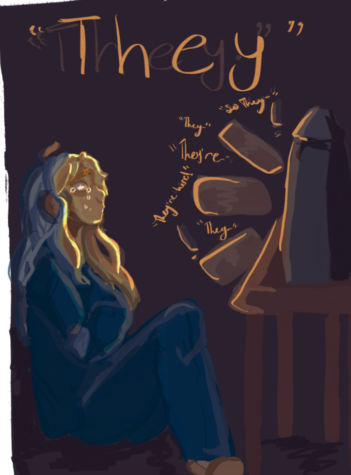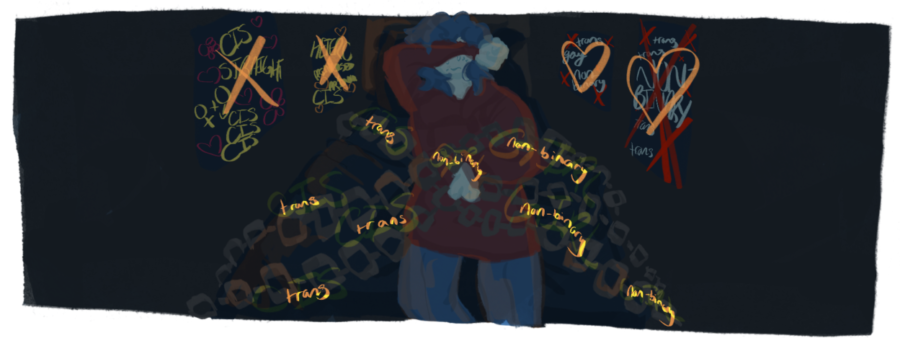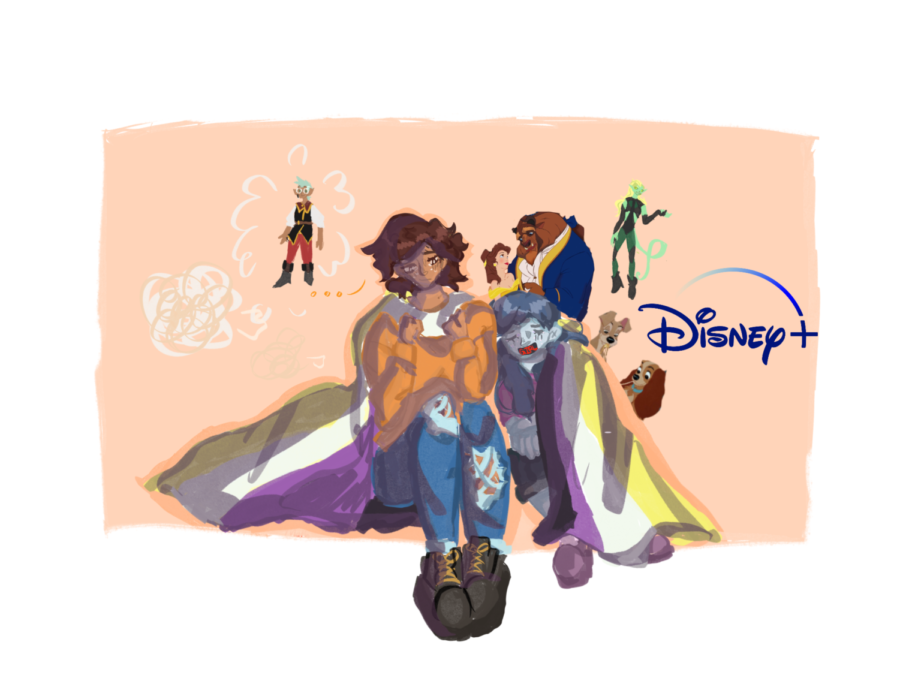Visible Pride
An illustration of myself holding a pride flag, the flag wrapped around my younger self. The illustration focuses that my past self had to deal with being underrepresented, but now I’m willing to accept myself with just one piece of representation. Illustration by Moth Payne.

June 22nd, 1955: Walt Disney published his first romance movie, “Lady and the Tramp.” “Lady and the Tramp” is still adored by many today, and it is one of Disney’s top grossing movies at $187 million when it came out in theaters. Ever since then, Disney has come out with multiple romance movies, most of them following the lead prince and princess who inevitably saves her in the end. Despite the common trope of the princess and the prince, or the princess and the lowlife, you name it– people of our society have consumed this media for multiple years, and continue to do so once another typical movie comes out.
Disney productions has produced amazing movies, amazing shows, and many things fans adore, and it is amazing how much this company has grown, however, you might be wondering– “What are you talking about? That doesn’t suit the title whatsoever.”
The reason as to why I mention Disney’s history and growth as a company is because it has been years ever since the first Disney movie had come out, and it’s always the same cisgender, hetero relationship trope. Disney has come out with pride merch, and LGBTQ+ characters, but they’re either stereotypical, or they’re background characters. That changed whenever Dana Terrace, the creator of “The Owl House”, premiered the show on Disney Channel on January 10th, 2020.
When I watched the show for the first time in the summer of 2021, Dana Terrace introduced Raine, a non-binary supporting character. I expected them to be some basic cisgender man, where their only role is to be the love interest for Eda, another main character in the show.
That wasn’t the case whatsoever, because whenever they were first introduced, the characters around them referred to them with they/them pronouns, no one set them aside with a specific gender group, and they were overall themselves– getting the point across that they were a non-binary character.
As a young non-binary kid, seeing Raine, a positive representation of being non-binary, it made me feel seen. All of my life, I always had that sinking feeling that I wasn’t myself in my own body. Like I was trapped inside a dog’s cage, waiting to get out, and waiting to see that representation that made me want to accept myself. So, when I first came out as non-binary to friends, I felt very insecure and uncertain about it, not sure if I was making the right decision of fully accepting myself, or if I was just some child wanting to identify with something different due to only being 10 years old.
Raine changed that. It’s crazy that a fictional character could impact someone in real life, but they can. It made me feel loved and not insane that I was non-binary, and that I was completely valid for how I identified. I wasn’t just a kid that was being delusional, or a kid that was lying to themselves. I was important, and I was seen. It is so important to represent our kids, because over time, they will feel like their identity is a lie because of the amount of straight, cis characters in our media.
Although there are many attempts at making representation, sometimes they don’t hit the mark. The remake of “She-Ra and the Princesses of Power” is an amazing example of horrible representation in the media. “She-Ra and the Princesses of Power” came out on November 13th of 2018 on Netflix, and it had such high expectations. The show was seen as a redemption of what “Voltron”, a show that was set up for failure whenever talking about representation, and what it could’ve been. So of course, everyone including myself was excited. “Voltron” had constantly committed queerbaiting, harmful representations of trans people, and even a hint of racism and stereotypes among chubby people as well.
“She-Ra and the Princesses of Power” had multiple body types, sexualities, ethnicities, and races represented. It seemed like it was the most perfect show, like if you watched it, you would immediately feel accepted and valid. But, it was the opposite.
Double Trouble is a shapeshifter mercenary and a spy for the main villain, the Horde. Double Trouble is one of the first openly non-binary characters in media, but is a lizard-like character when talking about appearance. This is a very harmful stereotype for non-binary people, which is being represented as other-wordly and an alien, as it’s following a strict androgynous aesthetic of not even being human.

Seeing this crushed me, because I knew it wasn’t right when I first watched it in my living room. What hurt the most, though, was the fact that the rest of my siblings had no problem with it, making me realize that I was the only one that understood the importance of how harmful that stereotype was. Double Trouble was only a character for them, but a huge obstacle in the way of accepting myself.
This is why representation is important. I discovered that I wasn’t cis whenever I was only 10 years old, and only recently felt like I was okay for being non-binary. I kept punishing myself and getting onto myself like I was my own parent for being non-binary, shaming myself for being who I am, and no child should have to deal with feeling entangled in a bunch of ropes, just waiting to be cut free. We shouldn’t have to be crying tears of joy anytime we are represented properly, just because it is that rare to see.
With representation properly represented in shows like “The Owl House”, it helps out so much with accepting myself. Back then, I had so much trouble even thinking about the fact that I was non-binary, or coming to terms with it and expressing myself as who I truly am. But now, I finally feel seen and discovered by just one show and one character. That’s why being represented in the media is so important, because it makes me feel like myself. It makes me feel human.
Your donation will support the student journalists of Francis Howell Central High School. Your contribution will allow us to purchase equipment and cover our annual website hosting costs. FHCToday.com and our subsequent publications are dedicated to the students by the students. We hope you consider donating to allow us to continue our mission of a connected and well-informed student body.






